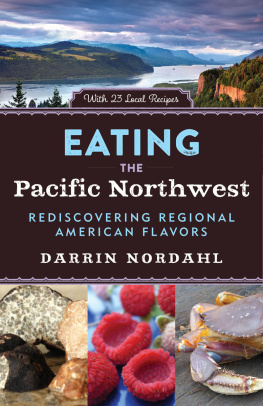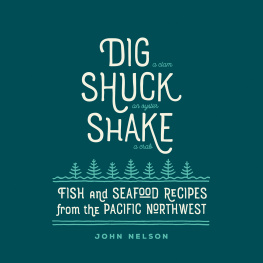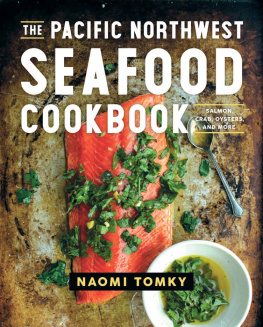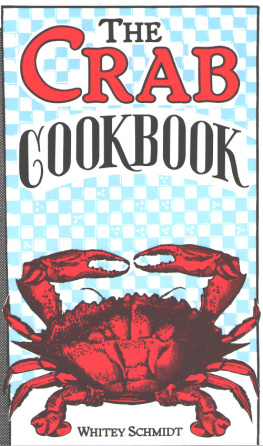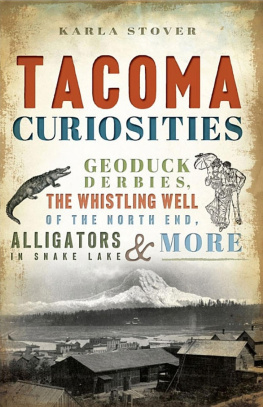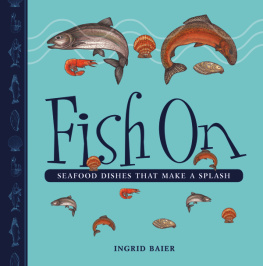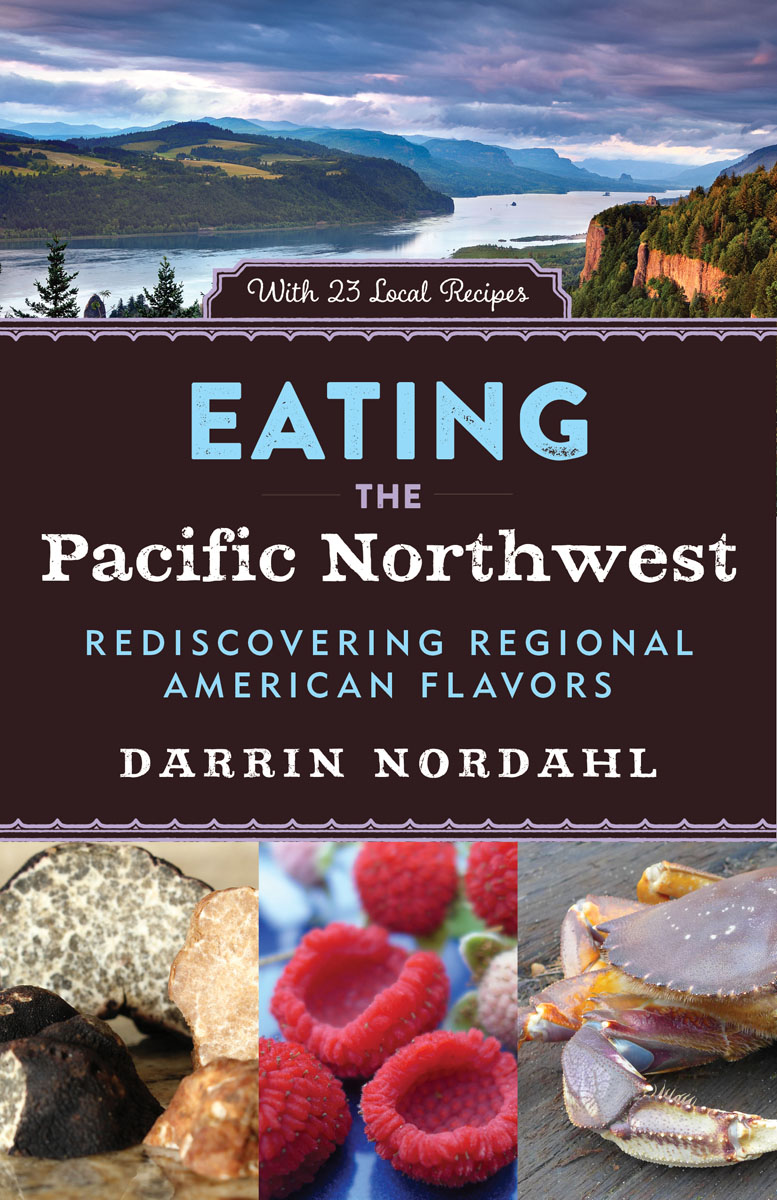

F rom the brisk waters of Seattle to the mushroom-studded forest surrounding Portland, author Darrin Nordahl takes us on a journey to expand our palates with the local flavors of the beautiful Pacific Northwest. There are a multitude of indigenous fruits, vegetables, mushrooms, and seafood waiting to be rediscovered in the luscious PNW. Eating the Pacific Northwest looks at the unique foods that are native to the region including salmon, truffles, and, of course, geoduck, among others. Festivals featured include the Oregon Truffle Festival and Dungeness Crab and Seafood Festival, and there are recipes for every ingredient, including Buttermilk Fried Oysters with Truffled Rmoulade and Nootka Roses and Salmonberries. Nordahl also discusses some of the larger agricultural, political, and ecological issues that prevent these wild, and arguably tastier foods, from reaching our table.
Copyright 2018 by Darrin Nordahl
All rights reserved
First edition
Published by Chicago Review Press Incorporated
814 North Franklin Street
Chicago, Illinois 60610
ISBN 978-1-61373-528-2
Library of Congress Cataloging-in-Publication Data
Names: Nordahl, Darrin, author.
Title: Eating the Pacific Northwest / Darrin Nordahl.
Description: First edition. | Chicago, Illinois : Chicago Review Press Incorporated, [2018] | Series: Rediscovering regional American flavors | Includes bibliographical references and index.
Identifiers: LCCN 2018021676 (print) | LCCN 2018022881 (ebook) | ISBN 9781613735299 (Pdf) | ISBN 9781613735305 (Mobipocket) | ISBN 9781613735312 (Epub) | ISBN 9781613735282 (cloth)
Subjects: LCSH: Cooking, AmericanPacific Northwest style. | LCGFT: Cookbooks.
Classification: LCC TX715.2.P32 (ebook) | LCC TX715.2.P32 N66 2018 (print) | DDC 641.59795dc23
LC record available at https://lccn.loc.gov/2018021676
Interior design: Sarah Olson
Layout: Jonathan Hahn
All photos by Darrin Nordahl, unless otherwise noted
Printed in the United States of America
5 4 3 2 1
For Kess
Hey, sweet baby
Dont you think maybe
We can find us a brand-new recipe?

CONTENTS

At its heart, a genuine food culture is an affinity between the people and the land that feeds them.
Barbara Kingsolver, Animal, Vegetable, Miracle
My meals shake [folks] from their routines, not only of meat-potatoes-gravy, but of thought, of behavior.
M. F. K. Fisher, The Gastronomical Me

INDIGENOUS: a species whose presence in a region is the result of only natural resources and means, without any human intervention. Synonymous with native.
Prologue
IDENTITY CRISIS


Road sign on US-101 along the Oregon coast.

I recently came across a fascinating bit of archaeology theory, and it completely changed my notion of American food.
About eight thousand years ago, the part of North America we now call the continental United States was heavily peopled. Archaic Indians, as archaeologists refer to them, banded together in tribes from Puget Sound to the Gulf of California to Chesapeake Bay. Gone were the mastodons, mammoths, saber-toothed tigers, and other megafauna; they disappeared with the retreating glaciers at the end of the Ice Age. Elk, bison, deer, rabbits, and squirrels were now the dominant wildlife. The boreal forests also retreated, replaced with deciduous hardwoods. Fruits and nuts abounded. Sea levels rose as the massive polar ice sheet melted, filling bays and estuaries. Ducks, geese, fish, and crustaceans flourished. The climate was warmer and drier than at the end of the Ice Age, and grasses proliferated. The American landscape eight thousand years ago was strikingly similar to todays.
What struck me most was the Archaic Indian diet. Archaeologists believe those ancient Americans consumed some 120 different species of plants and animals. Now, Im a foodie who takes pride in my diverse diet. Beef bores me. I prefer goat and lamb and elk. Chicken is bland, but duck and pigeon excite my palate. Ill take fava beans over green beans and persimmons over apples. I garnish my eggs with chervil and I season my fish with sumac. I know food and I eat it all. Still, 120 different plants and animals?
I began to doubt my own dietwas it as diverse as I thought it was? I grabbed a piece of paper and jotted down all the foodsplant, animal, and fungusI routinely consume as part of my annual menu. After about half an hour, I felt I had a fairly representative list of my yearly ingredients: 132 items. Aha! I have beaten you, prehistoric American settler! But the desire to launch into celebratory chest-thumping and nasal grunting quickly passed; it was a hollow victory, to be sure. I looked back at my list of foods and realized something unsettling. Bananas. Coffee. Mangoes. I was clearly benefitting from our global system of agriculture. Thanks to foods from faraway lands, I can consume a respectable diversity of ingredients. I am part of a culture eight thousand years more evolved (supposedly) than that of ancient America, able to eat food from all over the world. The Archaic Indians didnt have such convenience. Yet, my diet is hardly more diverse than that ancient societys, whose food shed consisted of little more than a few dozen square miles. They were the original locavores.
But if those early Americans werent consuming bananas, coffee, and mangoes, what were they eating? Corn, beans, and squashthe Three Sisters of the Native American dietwas my immediate guess. But I was wrong. Those three foods are domesticated crops that originated in Mesoamerica. For the Archaic Indians, who were hunters and gatherers, agriculture would come thousands of years later. And they certainly didnt hunt cows, pigs, or chickens, since these creatures were just beginning to be domesticated in Eurasia at the time.
What about avocados and artichokes? I thought. Theyve always struck me as prehistoric-looking foods, the kind that might have grown here since the dinosaurs roamed. But at the time of the Archaic Indians, avocados hadnt yet left their homeland of south central Mexico and artichokes were still nestled around the Mediterranean. It turns out our Florida oranges originally came from China as did Georgia peaches. I know papaya and pineapple arent American natives, but perhaps the apple is? Nope. The quintessential American fruit is a Colonialera adoption, arriving in the States via a circuitous route from Kazakhstan. Carrots likely originated in Persia, potatoes in Peru, and onions in West Pakistan. You can guess where Brussels sprouts originated.
Next page
